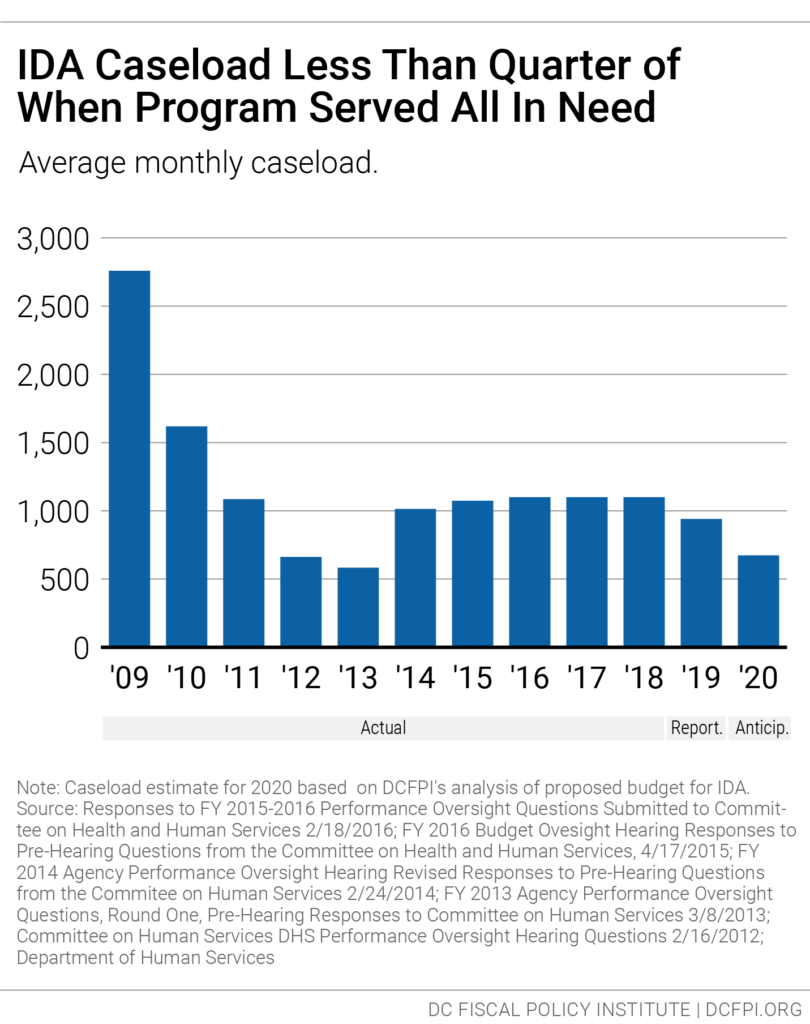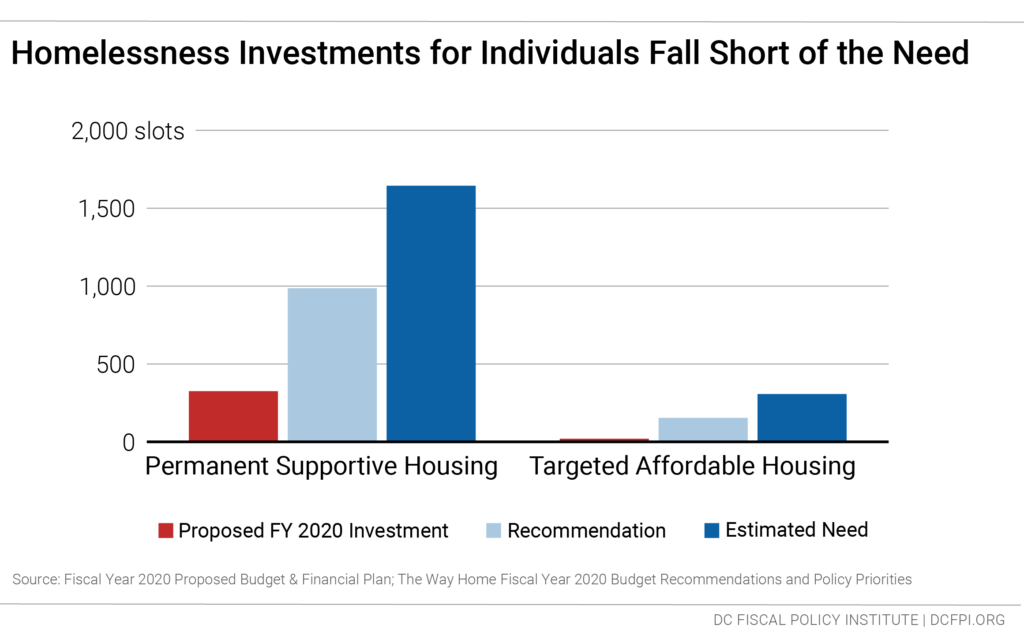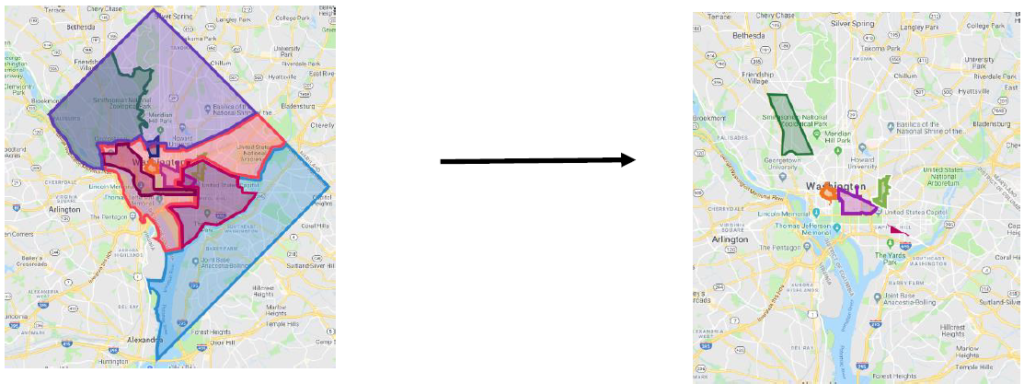Chairperson Nadeau and members of the Committee, thank you for the opportunity to testify today. My name is Kate Coventry and I am the Senior Policy Analyst at the DC Fiscal Policy Institute. DCFPI is a non-profit organization that promotes budget choices to address DC’s economic and racial inequities and to build widespread prosperity in the District of Columbia, through independent research and policy recommendations.
I would like to focus my testimony on Interim Disability Assistance, the SOAR program, and the Public Restroom Facilities Installation and Promotion Act of 2018. Additionally, I would like to highlight the investments made in the proposed homeless services budget but also to ask the Council to add additional funding because these investments fall far short of meeting the needs outlined in the District’s plans to end homelessness. Without greater funding, far too many residents will remain homeless. For those experiencing chronic homelessness, this may mean a life cut short. For others, it means lacking the stability needed to make progress in their education and employment. Finally, the loss of outreach funding threatens the wellbeing of 600 individuals living on the street.
Interim Disability Assistance Will Be Available to Fewer Residents in 2020
Interim Disability Assistance (IDA) provides modest, temporary cash benefits to adults with disabilities who have applied for federal disability benefits, Supplemental Security Income (SSI) or Social Security Disability Insurance (SSDI) and are awaiting an eligibility determination. The wait-time for federal benefit determination has skyrocketed in recent years, from 350 days in 2012 to nearly 600 days in 2017, leaving residents too sick to work but lacking benefits.[1]
IDA serves as a vital lifeline, allowing recipients to pay for basic needs such as transportation, medicine, and toiletries. When an individual is approved for SSI, the federal government reimburses the District for the IDA benefits the individual received.
The FY 2020 proposed budget combines $2.5 million in local funding with $800,000 in federal reimbursement for a total budget of $3.3 million. This is a cut of nearly $1 million from FY 2019. As a result, the number of people receiving IDA benefits monthly is expected to fall to 673, down from 940 in 2019. This caseload is less than 25 percent of what it was when the program participation was not capped and all those in need received benefits, around 2,750 residents in FY 2009 (Figure 1). DCFPI recommends that the Council add at least $1 million to keep the caseload at the FY 2019 level.

SOAR: Ensuring Residents Experiencing Homelessness Access Needed Benefits
The SSI/SSDI Outreach, Access, and Recovery program (SOAR) helps individuals who have a serious mental illness, medical impairment, and/or a co-occurring substance use disorder secure federal disability benefits. Because the application process is difficult to navigate, only 14 percent of these individuals are approved on initial application for these benefits. Using the SOAR model, DC has been able to help 73 percent of these individuals secure benefits on this initial application.
Despite this incredible success record, there is no funding to continue this expansion in FY 2020. DCFPI urges the Council to ask the agency if they can absorb SOAR costs into their budget. If not, the Council should add funding for this critical program.
Proposed Budget Makes Investments in Chronic Homelessness but Falls Short
A large number of single adults in DC are chronically homeless, meaning they’ve been homeless for a long time and suffer from life-threatening health conditions and/or severe mental illness. Families can also experience chronic homelessness, but it is less common; among families facing homelessness, the main challenge is low income and the inability to afford DC rents.
The proposed budget makes new investments towards ending chronic homelessness but falls far short of the estimated need (Figure 2). The budget also is well below the targets set by The Way Home campaign, an advocacy effort to end chronic homelessness in the District in the next four years.[2]

The proposed budget includes $8.8 million in new funding to provide Permanent Supportive Housing (PSH) to 325 individuals. PSH provides long-term housing and intensive case management to residents facing chronic homelessness who would otherwise have difficulty remaining housed This is just one-fifth of the estimated need of 1,644 slots, and it is just one-third of the target of 986 set by The Way Home campaign. The campaign is seeking to make rapid progress in expanding PSH because the individuals it serves are the most likely to die while homeless.
The proposed budget provides $421,000 for Targeted Affordable Housing (TAH) for 20 individuals, far below the estimated need of 307 units and The Way Home campaign goal of 154 units. TAH provides long-term affordable housing for formerly homeless residents, with no or minimal supportive services. TAH helps residents who need help paying rent after their Rapid ReHousing ends or who no longer need the intensive services provided by PSH but still need help to afford housing.
We urge the DC Council to preserve the current investments in TAH and PSA and invest an additional $18.2 million in PSH to serve 661 individuals and $2.6 million in TAH to serve 134 individuals.
Budget Makes Investments in Family Programs, But More is Needed
The proposed budget is notable because it provides enough funding to serve all families experiencing chronic homelessness—adding $6.3 million for 180 Permanent Supportive Housing (PSH) units for families.
The proposed budget also includes $2 million for 80 additional Targeted Affordable Housing (TAH) units. While the actual need is difficult to measure due to limited data, it is likely that the number of families experiencing homelessness who need long-term rental assistance is much larger. DCFPI encourages the Council to increase funding to provide TAH to 500 families.
Significant Investments in Youth Homelessness, But DC Needs to Scale Up to Meet the Need
Many youths who are experiencing homelessness do so without their parents or guardians and do not have children of their own. These “unaccompanied” homeless youth fall into two broad categories: those under age 18 and those who are 18 to 24 years old. In DC, youth under age 18 can only access housing and shelter dedicated to this population. Older youth, often called transition-aged youth (TAY), can access both TAY programs and adult housing and shelter.
This budget includes $975,000 for 30 new RRH subsidies, bringing the total number of RRH slots to 66. This is far below the target of 264 units set by Solid Foundations DC, the comprehensive plan to end youth homelessness[3]. At the same time, youth stakeholders have expressed a desire to experiment with program design before making large increases to the program.
The budget adds $513,000 for 15 new PSH slots. This is far below the 40 added slots called for in Solid Foundations DC, and below the 50 new slots recommended by the DC Alliance of Youth Advocates (DCAYA) based on input from youth and providers, given the number of highly vulnerable youth they identified.
The budget also adds $966,000 for 23 new transitional housing beds for youth. This is more than the 21 units recommended in Solid Foundations DC for FY 2020, but less than the 50 beds recommended by DCAYA, with input from youth and providers.
The budget does not include new shelter beds for TAY youth. Solid Foundations DC calls for 19 new beds, but this target was increased to 60 by DCAYA based on input from youth and providers and the numbers of homeless youth who do not have access to shelter.
The proposed budget maintains $400,000 from the FY 2019 budget to support services at the new 24-hour drop in center, as well as homelessness prevention and aftercare services. Aftercare provides individually tailored services to formerly homeless youth and their host family or friends to ensure that the housing placement is stable. These services can include conflict mediation and referrals to mental health and other services.
Finally, the budget does not include $250,000 for a pilot mentoring program, a need expressed by youth experiencing homelessness
As a member of the DC Alliance of Youth Advocates (DCAYA), DCFPI calls on the Council to make these critical investments in PSH, transitional housing, shelter, and mentoring.
Public Restroom Facilities Installation and Promotion Act
Passed unanimously by the Council in late 2018, the Public Restroom Facilities Installation and Promotion Act creates a working group to develop a two-pronged approach to promote restroom access: creating stand-alone restrooms and incentivizing businesses to allow the public to use their restrooms.
Public restrooms are fundamental to human dignity and human health. They are especially critical for people who are restroom-challenged. When seniors, pregnant women, young children, and people on certain medications have to go, they have to go urgently. Easily accessible, clean, safe restrooms make good business sense and help foster tourism. Knowing that there are public restrooms readily accessible, people are more apt to visit parks, ride their bikes, jog, and walk. As a result, more and more cities are investing in public restrooms.
The lack of access to bathrooms is not merely an inconvenience—it can have devastating health and public health consequences. Dr. Catherine Crossland of Unity Healthcare testified last year about her patients skipping lifesaving blood pressure, heart and HIV/AIDS medications because they can lead to an urgent need for the restroom. Southern California is experiencing the largest Hepatitis A outbreak since the 1990s because of the lack of toilets and handwashing facilities for residents experiencing homelessness. At least 20 people have died as a result.
The working group will identify sites with limited access to restrooms that would be appropriate to install a stand-alone bathroom model that is available 24/7, such as the Portland Loo.
The Loo is a prefabricated structure that takes up an area the size of a parking place. The Loo was designed in Portland in 2007 by an architect, business owners, and community members aiming to maximize safety both inside and out applying Crime Prevention Through Environmental Design principles and ensuring that it be economical and easy to maintain. Selecting an appropriate location for the Loo is very important for ensuring safety. It should be in an area that is visible from a distance and where there is a high level of pedestrian and vehicular traffic. For a Loo to be successful in a given location, it must be in an open visible area and there must be support and monitoring from the surrounding community, such as businesses, Advisory Neighborhood Commissions (ANCs), and neighborhood associations.
Crime prevention features include angled shutters along the bottom and above the eye level that protect privacy while ensuring that one can see how many people are inside. The restroom has an anti-graffiti coating and has lighting outside at night. To minimize installation costs, the site should be near water and sewer connections.
The safety, crime, and cleanliness measures combined with the fact that the Loo is relatively economical to install and maintain, has made it the stand-alone public restroom of choice in over 23 cities in the United States and Canada, including Portland, Oregon; Seattle, Washington; Greeley, Colorado; Salt Lake City, Utah; and Cambridge, Massachusetts; and Victoria, British Colombia.
While visiting Portland, I was able to use the Loo. Visible from several blocks away, the unit was cleaner than most department-store bathrooms and felt very safe as there was significant pedestrian traffic. When I was as an au pair in Switzerland, I appreciated that almost every town had a bathroom located in the train station or city hall. This greatly reduced my anxiety about traveling with a small child who had just begun potty training.
By increasing access to public restrooms, the District can be a friendlier place for tourists, children and their caretakers, residents with illnesses and disabilities, and residents experiencing homelessness. I urge the Council to fund the Public Restroom Facilities Installation and Promotion Act of 2018 in the FY 2020.
Budget Doesn’t Replace Expiring Federal Funds for Street Outreach
Additionally, there is a critical gap in funding for outreach services which help hard-to-reach individuals experiencing chronic homelessness, sleeping on the street, and suffering from severe health problems that are hard to manage while living outside. Homeless Street Outreach works in a coordinated way to help support some of our most vulnerable neighbors experiencing homelessness by connecting them to housing and other supportive services while also increasing health, safety, and quality of life while people are unsheltered. Over the past three years, DC has used federal funding to pay for street outreach that has ended homelessness for over 325 individuals. A review of studies found that outreach services improve health and housing outcomes.[4]
This vital federal funding expires at the end of April. Without sustainable funding for FY 2020 and beyond, current street outreach capacity will decrease by 25 staff people, leaving only 15 staff and significantly diminishing the supports available to over 600 individuals who are unsheltered. It will also greatly reduce the number of neighborhoods with outreach services (Figure 3). We are deeply concerned about how this cut will affect some of our most vulnerable neighbors. Without the assistance provided by professionally trained outreach workers, our businesses and houses of worship struggle to meet the needs of their homeless neighbors. We urge the Council to add $3.5 million in local funds to fill this critical gap in services.
Thank you, and I am happy to answer any questions.

[1] “597 Days and Still Waiting.” Terrence McCoy. The Washington Post. 11 Nov. 2017. http://www.washingtonpost.com/sf/local/2017/11/20/10000-people-died-waiting-for-a-disability-decision-in-the-past-year-will-he-be-next/
[2] The Way Home DC http://thewayhomedc.org
[3] Solid Foundations DC Strategic Plan to Prevent and End Youth Homelessness. May 2017 https://ich.dc.gov/sites/default/files/dc/sites/ich/page_content/attachments/Solid%20Foundations%20DC%20_web%201.5.pdf
[4] Jeffrey Olivet, Ellen Bassuk, Emily Elstad, Rachael Kenney and Lauren Jassil. Outreach and Engagement in Homeless Services: A Review of the Literature https://dmh.mo.gov/docs/mentalillness/litreview.pdf
